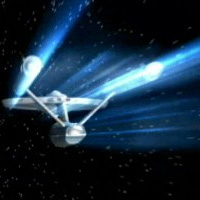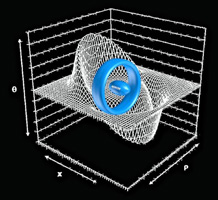 This is the second in my series on the different flavors of Faster Than Light (FTL) travel, and today I’ll be looking at the warp drive. The ideas for warp drive predate Star Trek, and they weren’t always called by that name, but Captain Kirk and the Enterprise are the iconic example of the warp drive. With a few words of technobabble, the universal speed limit is suddenly gone.
This is the second in my series on the different flavors of Faster Than Light (FTL) travel, and today I’ll be looking at the warp drive. The ideas for warp drive predate Star Trek, and they weren’t always called by that name, but Captain Kirk and the Enterprise are the iconic example of the warp drive. With a few words of technobabble, the universal speed limit is suddenly gone.
Yes, they paid lip service with the distinction between impulse drives and the warp drive, and over the years, they’ve filled our heads with all the technical details of subspace fields, warp bubbles, and such, but the basic result is that we are no longer bound by the upper limit of lightspeed. Let’s look at how some of the details shake out.
FTL-to-FTL interactions: Two ships travelling at warp speed can interact. That seems pretty universal. They can travel together, see each other coming, even take pot shots as they fly past. Sometimes there are a few restrictions, but they’re usually more of the nature of “that’s never been attempted at this speed!” In other words, they’re dramatic challenges for the engineer, not fundamental limitations on the physics.
FTL-to-sublight interactions: Yes, you can see the planet coming, and it can see you. You can steer around it and come back in for a strafing run. Stories with warp drive usually ignore the fact that you can’t literally see something coming at you faster than light with vague talk of “long-range sensors”.
Relativistic effects: Warp drives almost never deal with relativity. I think a lot of this is that once having dispensed with Einstein’s limits, they would rather not bring up real physics again. However, I have seen one or two instances of mild relativistic effects with warp drives. Kube-McDowell’s Trigon Disunity trilogy had a drive that ultimately moved the ship faster than light via some tricks of warped space, but the occupants were also travelling at relativistic speeds within that warped space. Thus, they experienced less than half the elapsed time as their Earthbound friends.
In-FTL Navigation: Warp-drive ships generally have no problem turning to starboard at faster than light speeds. Since we’re now pretending there’s nothing special about the speed of light and imagining ourselves in space-going navy vessels, there is no reason to suspect otherwise.
Speed Differential: Yes, the Joneses have a faster warp drive than you do. After all, if there is no longer an upper limit on speed, someone is always going to be at least little faster than you. Of course, since speed variation is possible, this also means you don’t have to be traveling at your maximum speed all the time. You can save warp 9 for the really dramatic moments.
Malfunctions: Whether it’s something as minor as a crack in the dilithium crystals or an ejected warp core, you’re not necessarily dead when things go wrong with your warp drive. Most of the time, you’re simply restricted to sublight travel again as Einstein takes a brief rest from spinning in his grave. Of course, many faults can be repaired, and you can get moving again. Failing that, you just have to stick out your warp thumb and wait for rescue.
Special traits: For storytelling, this is probably the easiest and to write and the simplest to grasp. It essentially ignores relativity and removes the problem of interstellar distances from the story. Rigel-4 is no longer hundreds of light-years away. It’s merely on the other side of the pond, so climb aboard the newest ship from the White Star Lines and have a safe… er… at least a short voyage.
 But ironically, this flagrant slap in the face to physics is starting to look like it just might, maybe, theoretically be almost possible. In 1994, Miguel Alcubierre proposed a way of changing the shape of space around us, shrinking it in the direction we wanted to travel and expanding it in the direction behind us. It requires some pretty crazy technology, the science for which is still pure speculation, but after about twenty years, it has a few people seriously considering it as a matter for research. How seriously? Apparently NASA is spending some of its precious half-pennies on it. It might not be much more than a publicity stunt, but there’s always that outside chance that it might be something huge.
But ironically, this flagrant slap in the face to physics is starting to look like it just might, maybe, theoretically be almost possible. In 1994, Miguel Alcubierre proposed a way of changing the shape of space around us, shrinking it in the direction we wanted to travel and expanding it in the direction behind us. It requires some pretty crazy technology, the science for which is still pure speculation, but after about twenty years, it has a few people seriously considering it as a matter for research. How seriously? Apparently NASA is spending some of its precious half-pennies on it. It might not be much more than a publicity stunt, but there’s always that outside chance that it might be something huge.
So, tune in next week when we take a tour of hyperspace…
The whole series: Intro, Warp Drive, Hyperspace, Wormholes, Jumping, Summary
